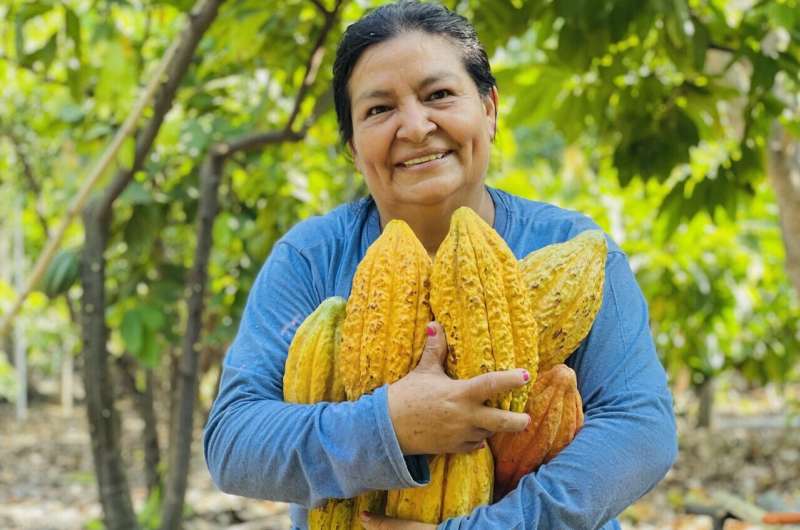This article has been reviewed according to Science X's editorial process and policies. Editors have highlighted the following attributes while ensuring the content's credibility:
fact-checked
peer-reviewed publication
proofread
Researchers map cadmium in cacao: 'The problem isn't as bad as we thought'

Cadmium naturally occurs in the soil of much of Latin America's cacao farms, and is absorbed by the plants. With EU regulations restricting the amount of cadmium allowed in chocolate imports, it is important for farmers to know where they can grow cacao that is fit for the global market. Researchers have compiled a map that aims to address this challenge.
In 2019, a wind of uncertainty was rustling through the thick green leaves of cacao trees from Venezuela to Peru. After 4 years, the European Union had implemented limits on cadmium—a toxic heavy-metal— in chocolate and cacao. Although the limits are set in the final product, preliminary data suggested that chocolate produced from Latin American beans was higher in cadmium than in other parts of the world.
For many countries in the region, cacao is an export crop, produced by hundreds of thousands of smallholder farmers living in difficult economic situations. With the biggest market being the EU, these limits put an additional worry on the cacao value chain with possible implications not only for sellers, but also on the livelihoods of farmers.
However, although it was becoming obvious that the problem did not affect the whole of the cacao growing region in Latin America, it was not clear which regions were the worst affected or what the cause was.
Samples from across Peru show that soil is key
The team spent the past few years sampling cacao and soil across the length and breadth of Peru. This culminated in a study published in Science of the Total Environment, which synthesized data from over 2,000 samples across Peru, making it the largest study to date of cadmium and cacao.
The study demonstrated that the most important predictor of cadmium in cacao beans is cadmium in the soil. In other words, it depends on the location of the farm. Cadmium is taken up by the roots of cacao trees, and the study confirmed that the amount of uptake is directly linked to the concentration of cadmium in the soil.
This helps to explain why cadmium is a greater concern in Latin America, which has younger, less eroded soils when compared to other cacao producing regions. The study also showed how variable soil cadmium levels are across the country, due to the complicated geological history of Peru, not only of the geology under a farm, but also soil moved by rivers over millennia from mineral rich deposits in the Andes. In addition, soil pH, soil type and even rainfall all influence the extent to which cadmium accumulates in cacao beans.
Good and bad news for farmers
The good news is that the study shows the majority of cacao grown in Peru can be used to make chocolate that will comply with the EU cadmium limits, with over 80% of farmers expected to experience little to no impact on their livelihoods.
The bad news is that there are areas in the country that, due to their soils, cannot easily comply. These areas include several valleys in the department of Piura, famous for a native fine flavor cultivar called Blanco de Piura. It is sold to high-end, European niche markets for its distinctive taste, which in turn allows farmers to receive a better price for their beans. With high levels of cadmium in many valleys in Piura, farmers are forced to sell into less lucrative internal markets.
The study estimated that up to 89% of the smallholder farmers in this region are already experiencing a financial loss because of high cadmium levels. Cooperatives and buyers are working hard to carefully select and mix cacao from farms in Piura to allow consumers to continue enjoying the unique flavors, ensuring low cadmium in the chocolate while also maintaining prices for the farmers.
A map to predict cadmium levels
To help understand the variation in cadmium across the country, the scientists have consolidated all the data in an interactive map. Available at cacaodiversity.org, the map provides predictions about the levels of cadmium likely to be present in soils and cacao beans in Peru's cacao-growing areas.
Besides informing the sector about the problem, this user-friendly resource aims to reach policy- and other decision-makers. This knowledge is also being put to use to further scientific studies on solutions to minimize cadmium uptake by cacao trees in a regional project by the EU Desira program in Ecuador, Colombia, and Peru.
More information: Evert Thomas et al, The distribution of cadmium in soil and cacao beans in Peru, Science of The Total Environment (2023). DOI: 10.1016/j.scitotenv.2023.163372
Journal information: Science of the Total Environment
Provided by The Alliance of Bioversity International and the International Center for Tropical Agriculture


















